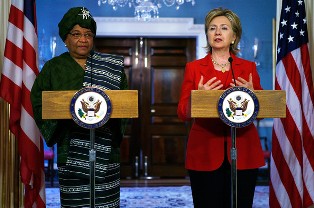 The authors were members of the HELP Commission which in December 2007 made recommendations to Congress for the reform of U.S. Foreign Assistance. Leo Hindery, Jr. is chairman of the Smart Globalization Initiative at New America Foundation and a media industry executive; C. Payne Lucas is the co-founder of Africare, and Jerry Climer is president of the Public Governance Institute.
The authors were members of the HELP Commission which in December 2007 made recommendations to Congress for the reform of U.S. Foreign Assistance. Leo Hindery, Jr. is chairman of the Smart Globalization Initiative at New America Foundation and a media industry executive; C. Payne Lucas is the co-founder of Africare, and Jerry Climer is president of the Public Governance Institute.
As Secretary of State Clinton wound down her tour of Eastern African nations with a visit to Liberia, she saw firsthand an important case study for her newly announced “Quadrennial Diplomacy and Development Review” (QDDR), which will in the future periodically examine all of the recipients of U.S. foreign assistance and make detailed assessments of their all-of-country long-term humanitarian and development needs.
When Liberia, a Tennessee-sized country of 3.2 million people, emerged in 2005 from 14 years of devastating internal warfare, President Ellen Johnson Sirleaf assumed leadership of a country with no electricity, few intact buildings and almost no roads, no prior schooling for an entire generation, no trained police force, and less than $100 million a year in government revenues.
Now just four years later, as the beneficiary of significant foreign assistance since 2005, Liberia is one of the African countries friendliest toward the United States and the developed world and certainly the one most willing to proclaim those friendships. Numerous donors are now committed to helping Liberia, including the U.S. which is currently Liberia’s single largest government donor.
But even though there is economic progress visible almost everywhere in the country, Liberia is still one of the poorest African nations with an average life expectancy of just 44 years. And Secretary Clinton saw, also firsthand, that there is still not enough money in the long-term foreign assistance pipeline to complete the country’s restoration. Nor is there a sufficiently large foreign commitment to equally important non-monetary assistance, especially for leadership training and good governance initiatives.
Until there are significantly more capital assets in place and expanded partnerships with foreign donors, NGOs and overseas companies and agencies, Liberia will not have large-scale sustained development. And this is precisely the purpose and value of the QDDR, for as the prominent development economist Paul Collier discovered, it is often better not to provide any assistance to developing countries with recent violent pasts, than to provide an insufficient amount.
The QDDR was put in place both to fill the knowledge gap of how much assistance is enough and to help refute those naysayers, in Congress and elsewhere, who continue to deny the imperative of foreign assistance. But down the road, QDDR’s most important result may be helping Liberia and other stressed countries rid themselves, once and for all, of the overhanging “conflict traps” that Collier also identified.
A conflict trap is the dangerous reality that just “the experience of having been through a civil war roughly doubles the risk of another conflict” and that continued “low income and slow growth make a country [especially] prone” to such recurrence.
The solution to Liberia’s particular conflict trap will be found mostly in creating productive jobs and in gaining stability and safety through large-scale police training and civil institution building. These are no small tasks, but each represents areas in which foreign donors are especially adept.
As Senate-appointed members of the 2005-2007 U.S. Commission to “Help Enhance the Livelihood of People” (the HELP Commission) and from other experiences, we have had many opportunities to assess conditions on the ground in Africa and we know that addressing needs of the scale still confronting Liberia is a monumental challenge.
Consider just electricity.
Right now, the only power in the entire country comes from a few personally-owned generators and a tiny 10-megawatt public utility in the capital city of Monrovia that together produce only about 20% of the country’s needs. The only potential large-scale source of electricity, which is a dam on the St. Paul River, could, with the help of the donor community, be repaired in a few years time. And yet when finished there would still be none of the transmission lines, billing systems or payment mechanisms needed for even the most modest national grid and distribution system.
This challenge is just one example of what the QDDR process is all about, and why the HELP Commission in its final report recommended implementation of just such an initiative.
Development and diplomacy are critical steps toward a safer world, and when Liberia’s QDDR is complete, it will be obvious to everyone that this country – which is so important in Africa and so entwined with our nation’s early history and own civil war – must never be allowed to slip back into lawlessness. Importantly, the specific amounts, manner and time frames of the foreign aid that’s needed into the future will be just as apparent.
— Leo Hindery, C. Payne Lucas, and Jerry Climer


15 comments on “Guest Post by Leo Hindery, C. Payne Lucas, Jerry Climer: Liberia – The Perfect Foreign Assistance Test Case”